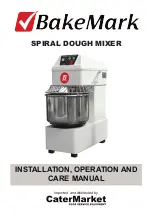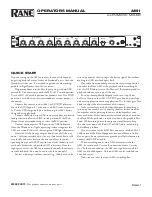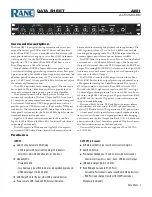
28
GL2400
User Guide
Applications for the Matrix
The matrix is a ‘mixer within a
mixer’, a versatile toolbox of outputs you can use to satisfy a host of
applications. Each of the 4 outputs is mixed from any combination of
the groups, L, R and an external input as dialled up on the 7 source
rotaries (hence a ‘7x4’ matrix). Its master level can be adjusted
independently. Using combinations of the outputs you can create
mono, stereo or multiple output mixes. Some applications include:
Mono Recording
If you are working with a stereo PA you can
combine L and R into a matrix output to produce a mono mix feeding
a recorder, video camera and so on. Raise the L and R rotaries to the
2 o’clock position to sum them together. You can use the built-in
1kHz tone generator to feed a line-up tone to the connected recorder.
Stereo Recording
Raise L to the unity 3 o’clock position in one
matrix, R in another to create a stereo pair that follows the LR mix.
You can adjust the balance to compensate for the acoustic sound in
the room using the groups, and even add audience ambience
(described later).
Remote Broadcast
Create a mono or stereo feed as described
above. Use the tone generator to send a ‘slate’ signal to the
destination for line-up. You can check your level in the headphones
before you send it by muting the matrix and selecting AFL.
Zone Feeds
Send independent relay feeds to additional locations
such as the foyer, dressing rooms, cry room, balcony and so on. You
can use the groups to adjust the balance to suit the destination, for
example to boost the orchestra against the vocals. Feed the output
through an EQ to tune the speaker for the local acoustics.
Delay Fill Speakers
Use the matrix to feed additional fill speakers for
distributing the sound more evenly around a large venue, for example
centre fill, stage front fills, under balcony or rear fills, or ‘mix island’
delay tower at a festival. To aid intelligibility for the nearby listeners
without moving their focus from the stage, the send should be delayed
using an in-line delay processor. As a rule of thumb, delay 1mS per
foot difference between the listener and the fill and the listener and the
main speakers. Now add a few milliseconds ‘Haas effect’ delay so the
listener hears the main speakers slightly before the fill. Keep the fill
level about 10dB or so below the main PA sound at that location. It
may help intelligibility to boost the vocals above the instruments in the
fills, and to use an EQ to cut the extreme LF and HF frequencies.
Hearing Assist
It is a growing requirement that venues provide a
hard-of-hearing inductive loop, IR or wireless broadcast for the hearing
impaired audience. The matrix is ideal for this application as you can
combine a stereo LR mix into mono, add groups to help vocal
intelligibility, patch in an external ambience source, and add
processing such as EQ and limiters which may be needed.
Additional Monitor Mixes
You could use the matrix to create some
additional monitor mixes when you run out of auxes, this time made
up from a mix of the groups, LR and external input. The LR could be
used to create a general overall balance, and then the groups added
according to musician preference. Groups could be routed from 'me
only' channels associated with each musician, or traditionally grouped
sources. The musician could get a balance from, say, the overall
stereo mix, drums, brass, keyboards, ‘me only’ and ambience, a very
quick way of mixing. You could also use the EXT IN to add ambience
pickup, very useful if you are creating in-ear (IEM) mixes. Use two
matrices to create stereo monitor feeds.
Combining Two Consoles into a Single PA
In a festival situation
you may have a support band wishing to patch in their own console.
One way to do this is to feed the PA from a pair of matrices, and then
use EXT Inputs to combine the external console with the main LR mix.
AFL
AFL
OO
LEVEL
O
O
R
OO
L
OO
O
LEVEL
O
MUTE
+6
+6
MUTE
O
+6
O
+6
O
O
+6
R
+6
L
O
+6
O
+6
2
3
GRP
4
OO
GRP
OO
1
GRP
O
O
GRP
2
O
O
3
+6
4
GRP
+6
GRP
O
+6
O
+6
O
1
+6
GRP
GRP
O
+6
O
O
EXT
O
+6
EXT
O
+6
IN
IN
O
LEVEL
OO
+6
O
+6
O
O
R
L
O
+6
O
+6
2
O
O
3
4
GRP
GRP
O
+6
O
+6
O
1
GRP
GRP
O
+6
O
EXT
O
+6
IN
O
LEVEL
OO
+6
O
+6
O
O
R
L
O
+6
O
+6
2
O
O
3
4
GRP
GRP
O
+6
O
+6
O
1
GRP
GRP
O
+6
O
EXT
O
+6
IN
AFL
MUTE
AFL
MUTE













































